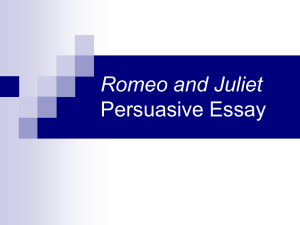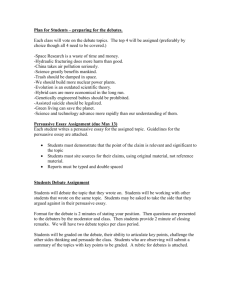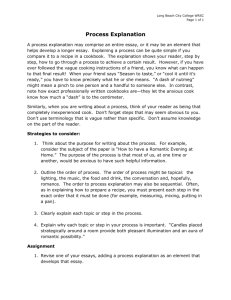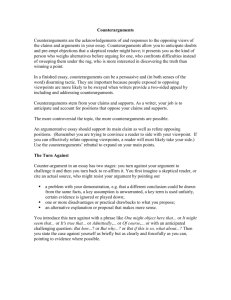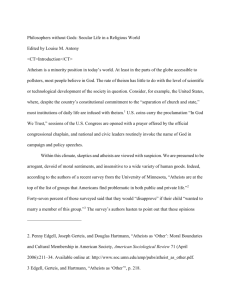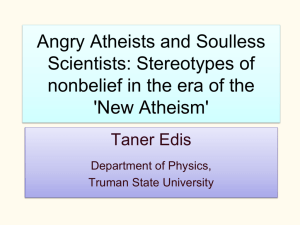Contribution Rough Draft - Andrew.cmu.edu
advertisement
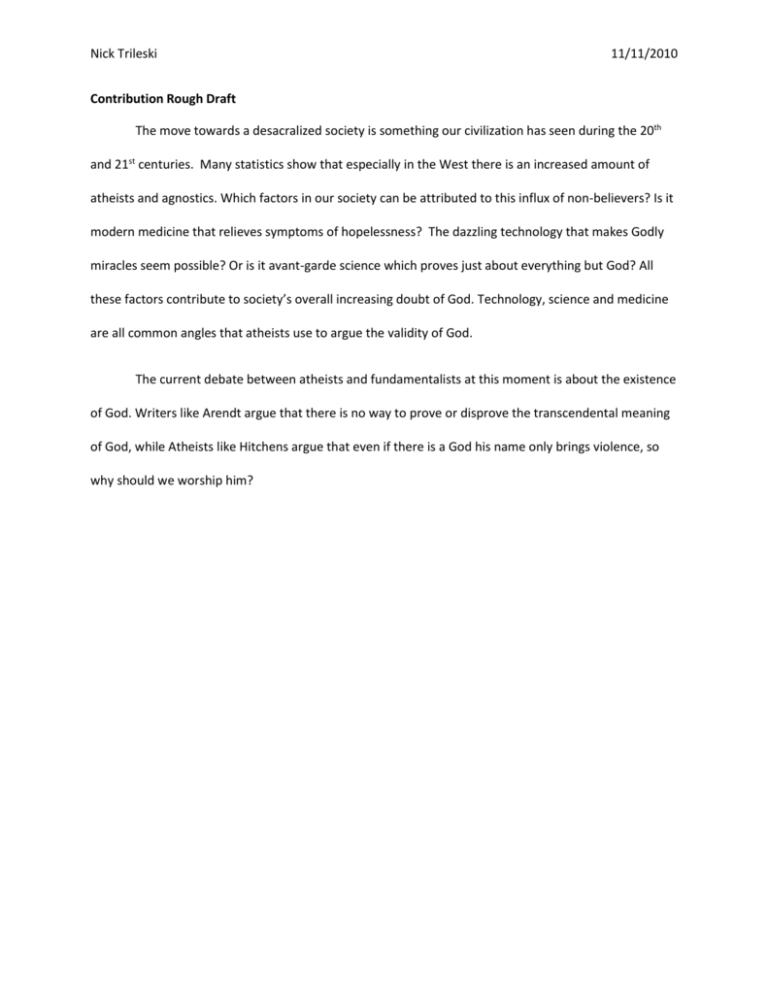
Nick Trileski 11/11/2010 Contribution Rough Draft The move towards a desacralized society is something our civilization has seen during the 20th and 21st centuries. Many statistics show that especially in the West there is an increased amount of atheists and agnostics. Which factors in our society can be attributed to this influx of non-believers? Is it modern medicine that relieves symptoms of hopelessness? The dazzling technology that makes Godly miracles seem possible? Or is it avant-garde science which proves just about everything but God? All these factors contribute to society’s overall increasing doubt of God. Technology, science and medicine are all common angles that atheists use to argue the validity of God. The current debate between atheists and fundamentalists at this moment is about the existence of God. Writers like Arendt argue that there is no way to prove or disprove the transcendental meaning of God, while Atheists like Hitchens argue that even if there is a God his name only brings violence, so why should we worship him? Nick Trileski 11/11/2010 Contribution Essay 76-101: Interpretation and Argument Carnegie Mellon University Fall 2010 Write a paper in response to the conversation our authors have been having all semester. The proposal is due Wednesday, November 3. The rough draft is due Friday, November 12, at the beginning of class. The final draft is due Friday, December 10, by 5pm. Please turn in your rough draft with my comments along with the final. The Contribution Essay should be 1800-2700 words, typed, double-spaced. It should include a Works Cited. You must hand in your drafts (both rough and final) in both electronic and paper form. RESEARCH QUESTION Framing your argument in response to a question will help keep it focused. It’s fine to change the question while you are writing your draft; sometimes you won’t know what question your answering till you’ve already answered it. Nick Trileski 11/11/2010 STATE OF THE DEBATE A good contribution paper builds on the skills you practiced during the synthesis paper. Show the state of the debate about the issue you are addressing with a mini-synthesis of perspectives about the issue. This means citing authors and approaches, but in a condensed form compared to the synthesis paper. This sets up where your contribution fits into the overall conversation. ANSWER THE QUESTION This is your “contribution” – the position you are arguing. It’s important to explain where it fits into the overall debate (that is, the authors we’ve read in class). Two ways of framing a contribution are: (1) identifying a “gap” that seems to be overlooked in the debate as a whole (i.e., our class readings), or (2) using a specific case (like zombies) to illustrate the issues we’ve already looked at in class. As you figure out your contribution, you may need to revise your research question so that it reflects the answer you are giving. COUNTERARGUMENTS Acknowledge counterarguments – whether directly from our authors or simply what you anticipate from a reader. Confronting counter-arguments can persuade readers (1) that your view makes sense and (2) that your argument considers this critique and can acknowledge where its points have merit. You must make it clear that there are good reasons for not being swayed by the counterarguments you introduce. SUBHEADINGS Your job as a writer is to make your ideas clear to your reader. Help your reader navigate your text by “chunking” your essay into meaningful sections that are separated and defined by subheadings. For this essay, your subheadings will be most effective when they forecast the main claim of the section. AUDIENCE Direct this paper toward a Carnegie Mellon University academic audience that is interested in religion and power as the course has defined it. Basic ideas about religion and power would be familiar to your readers, but they may not have read the authors you’ve included in your essay, so you should be sure to provide definitions. They may also not be familiar with the complexities we have explored in this course. Hence, some background or context is necessary for your reader to understand the significance of the question you’re exploring – i.e., that it’s not been addressed and you’re filling a gap in the literature, etc.

